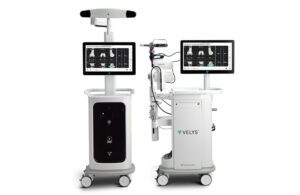
Johnson & Johnson Group CIO and Global Vice President of Medical Devices Larry Jones [Photo courtesy of J&J]
Two leaders from Johnson & Johnson connected with Medical Design & Outsourcing this week to discuss the medical device maker’s partnership with Microsoft, the cloud’s potential for medical devices and to offer advice for medtech engineers designing for connectivity.
In January, New Brunswick, New Jersey–based Johnson & Johnson (NYSE:JNJ) named Redmond, Washington-based Microsoft (NASDAQ:MSFT) as its preferred cloud provider for digital surgery solutions and partner on building out J&J’s digital surgery platform and internet of things (IoT) device connectivity.
Johnson & Johnson Group CIO and Global Vice President of Medical Devices Larry Jones and Office of Digital Innovation Leader Peter Schulam (who also serves as global head of medical affairs, clinical affairs and pre-clinical research for Johnson & Johnson Medical Devices Cos.) sat down with MDO for the following conversation, which has been edited for space and clarity.
MDO: What cloud computing capabilities exist today at J&J as you’re getting the Microsoft cloud partnership started?
JONES: We have a pretty audacious vision to not only optimize our devices in the marketplace, but to take advantage of (the cloud and) those things associated with the cloud to create an experience beyond just a robot or a device, to create new standards of care and surgery, but also to optimize and create new insights into the operating room. And what the cloud provisions us is an opportunity to connect and create smart devices in the OR setting, whether it’s our endo cutters, whether it’s other instruments, certainly our robotics platform, and when you consider ingesting and supporting that data broadly and coupling that with the procedure or EMR integration in a very compliant and secure way, you can create new capabilities, whether they be machine learning, artificial intelligence, and when you add edge computing you actually can create a very powerful ecosystem. That’s our vision. Add things like telementoring and telehealth — the cloud is key and critical to all of those. We believe we can transform healthcare across the board for our customers and create something extraordinary and something very different. Our partnership with Microsoft is to help some of the assets we already have in marketplace and grow those and, and use it as an innovation engine not only for IoT and health cloud, but actually making the cloud the small part of a bigger vision of what we want to do.

Johnson & Johnson’s VELYS robotic system for orthopedic surgery [Image courtesy of Johnson & Johnson]
MDO: Are there specific J&J devices you would call out as being the smartest of the cloud-connected?
JONES: Right now we’re connecting our Velys total knee replacement robotic platform. We have other opportunities in our supply chain. For example, we are doing demand sensing from a surgery perspective, integrating into auto planning or planning procedures and aggregating that data and using it to make sure that not only the procedure’s done well — Peter can speak to that — but it’s really about taking inefficiencies out of the process of leveraging the cloud. I got into a very interesting discussion with an individual who’s really intimidated, scared of the cloud. And I asked them, “How would you get your COVID results if it were not for the cloud?” And, and I think some people don’t understand that it just doesn’t appear on your phone. The cloud is a leverageable asset, a secure asset. That’s not what it was 10 years ago, and I think there are more opportunities to exploit it moving forward.

Johnson & Johnson Office of Digital Innovation Leader Peter Schulam [Photo courtesy of J&J]
SCHULAM: We want to shape the future of healthcare. We see it as being smarter, less invasive, more personalized. … Currently a lot of our devices are mechanical, but they’re undergoing this evolution. Something that basically seals vessels, for instance, is a mechanical device, but it has a generator. If you were to put sensors on that and generate data, aggregate that data, and then process that data, can you gain information that would be beneficial to the surgeon and in taking care of the patient? One of the projects at J&J is working with the data that they can generate from the generator. Looking at surgical video, they’ve been able to build an algorithm that helps determine the quality of the seal of the vessel before you actually cut, so potentially it can decrease bleeding. [What does it mean to] take a mechanical device and make it smart? Very simplistically, you’re now generating data, you can aggregate or ingest that data, and then you can process that data. That processing provides insight and potential predictive analytics. And so if we can develop devices now that help decrease patient outcome variability, then we can improve the standard of care. You can also actually start moving towards democratization of care so everyone is gaining access to high-quality care. … Then once your imagination gets going, as Larry’s mentioned, you start looking at video and telementoring, and you start to converge these technologies. It’s limitless.
MDO: What does cloud computing mean for how medical device designers and engineers should be thinking?
JONES: It means designing connectivity in your solution. Expect connectivity to be a part of your solution. Design with security in mind as part of the product offering. And that’s one of the things we’re becoming much more astute and aware of. Being able to understand how the cloud can collect that data and to be very proactive in what sensors you’re using, what are you designing, even to the point of what preventive maintenance looks like. That has to be designed up-front, not an afterthought. We’ve had some lessons learned where we want those capabilities, but they all start at the design process. Learning from Microsoft, as we’re designing products, don’t try to solve problems that’ve already been solved. There’s a lot of leverage across the board and that’s why we’re we believe this audacious task is gonna take partnerships to do that.
SCHULAM: When you’re looking at a medical device in the conventional manner, you spend a long time developing, you launch, and then you never iterate. Guess what? In the software world and the agile world, it’s exactly the opposite: a minimal viable product and multiple iterations. So what we have to do is create this hybrid innovation cycle. That’s extremely unique. What’s the difference in the future? The future is that you have to have both capabilities overlapped in order to create that vision. And I think that J&J is really focused and moving in the right direction.
JONES: I remember when we had constraints on any product design. Storage was expensive. Computing was expensive. Battery life was challenging. Things like connectivity and speed, with 5G, 6G forthcoming with the cloud and being able to amass unlimited storage at a fraction of a cost, those constraints in your design aren’t as plentiful as they were in the past. I’m not a mechanical engineer, but I do believe that you’re now building without constraint. There are so many things to compliment the art of the possible because of advances in technology that were not true as many as 10 years ago.
Come back to MDO next week for the second half of this conversation, exploring what’s possible with the cloud, regulatory considerations and the ideas that keep Jones and Schulam up at night.